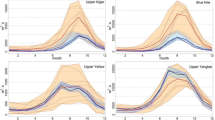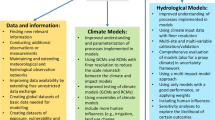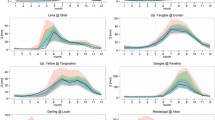Abstract
This paper introduces the Special Issue “Hydrological Model Intercomparison for Climate Impact Assessment”. We describe the river basins used as case studies, the input data, the hydrological models, and the climate scenarios applied in the multi-model framework. We also summarize the main results of the papers contained in this Special Issue.



Similar content being viewed by others
References
Arheimer B et al (2012) Water and nutrient simulations using the HYPE model for Sweden vs. the Baltic Sea basin—influence of input-data quality and scale. Hydrol Res 43(4):315–329
Arnold JG et al (1993) A comprehensive surface-groundwater flow model. J Hydrol 142:47–69
Arnold JG et al (1998) Large area hydrologic modeling and assessment part I: model development. J Am Water Resour Assoc 34:73–89
Bergström S, Forsman A (1973) Development of a conceptual deterministic rainfall-runoff model. Nord Hydrol 4:147–170
Boyle DP (2001) Multicriteria calibration of hydrological models. PhD Dissertation. Dep Hydrol Water Resour Univ Ariz, Tucson
Christensen NS, Lettenmaier DP (2007) A multimodel ensemble approach to assessment of climate change impacts on the hydrology and water resources of the Colorado River Basin. Hydrol Earth Syst Sci 11:1417–1434
Donnelly C et al (2015) Using flow signatures and catchment similarities to evaluate a multi-basin model (E-HYPE) across Europe. Hydrol Sci J. doi:10.1080/02626667.2015.1027710
Eisner S et al. (2016) An ensemble analysis of climate change impacts on streamflow seasonality across 11 large river basins. Clim Change. doi:10.1007/s10584-016-1844-5
Flörke M et al (2013) Domestic and industrial water uses of the past 60 years as a mirror of socio-economic development: a global simulation study. Glob Environ Chang 23(1):144–156
Gassman PW et al (2014) Applications of the SWAT model special section: overview and insights. J Environ Qual 1–8. Doi:10.2134/jeq2013.11.0466
Gelfan A et al (2015) Large-basin hydrological response to climate model outputs: uncertainty caused by internal atmospheric variability. Hydrol Earth Syst Sci 19:2737–2754
Gelfan A et al (2016) Climate change impact on the water regime of two great arctic rivers: modeling and uncertainty issues. Clim Change. doi:10.1007/s10584-016-1710-5
Gosling S et al (2016) A comparison of changes in river runoff from multiple global and catchment-scale hydrological models under global warming scenarios of 1°C, 2°C and 3°C. Clim Change. doi:10.1007/s10584-016-1773-3
Haddeland I et al (2014) Global water resources affected by human interventions and climate change. Proc Natl Acad Sci USA 111(9):3251–3256
Hamlet AF, Lettenmaier DP (1999) Effects of climate change on hydrology and water resources in the Columbia River Basin. J Am Water Resour Assoc 35:1597–1623
Hattermann F. et al. (2016) Cross-scale intercomparison of climate change impacts simulated by regional and global hydrological models in eleven large river basins. Clim Change. doi:10.1007/s10584-016-1829-4
Herman JD et al (2013) Time-varying sensitivity analysis clarifies the effects of watershed model formulation on model behavior. Water Resour Res 49:1400–1414
Huang S et al (2016) Evaluation of an ensemble of regional hydrological models in 12 large-scale river basins worldwide. Clim Change. doi:10.1007/s10584-016-1841-8
Krysanova V, White M (2015) Advances in water resources assessment with SWAT—an overview. Hydrol Sci J 60(5):771–783
Krysanova V et al (1989) Simulation modelling of the coastal waters pollution from agricultural watershed. Ecol Model 49:7–29
Krysanova V et al (1998) Development and test of a spatially distributed hydrological/water quality model for mesoscale watersheds. Ecol Model 106:261–289
Krysanova V et al (1999) Modelling river discharge for large drainage basins: from lumped to distributed approach. Hydrol Sci J 44:313–331
Krysanova V et al (2015) Modelling climate and land use change impacts with SWIM: lessons learnt from multiple applications. Hydrol Sci J 60(4):606–635
Kumar R et al (2013a) Implications of distributed hydrologic model parameterization on water fluxes at multiple scales and locations. Water Resour Res 49(1):360–379
Kumar R et al (2013b) Towards computationally efficient large-scale hydrologic predictions with a multiscale regionalization scheme. Water Resour Res 49(9):5700–5714
Liang X et al (1994) A simple hydrologically based model of land surface water and energy fluxes for general circulation models. J Geophys Res 99:14415–14428
Lindström G et al (2010) Development and test of the HYPE (Hydrological Predictions for the Environment) model—a water quality model for different spatial scales. Hydrol Res 41(3–4):295–319
Menzel L et al (2006) Impact of climate change on the regional hydrology—scenario-based modelling studies in the German Rhine catchment. Nat Hazards 38:45–61
Mishra V et al (2016) Multimodel assessment of sensitivity and uncertainty of evapotranspiration and a proxy for available water resources under climate change. Clim Chang (in press). This SI
Moore RJ (1985) The probability-distributed principle and runoff production at point and basin scales. Hydrol Sci J 30(2):273–297
Motovilov YG (2013) ECOMAG: a distributed model of runoff formation and pollution transformation in river basins solution. IAHS Publ 361:227–234
Motovilov YG et al (1999) Validation of a distributed hydrological model against spatial observation. Agric For Meteorol 98–99:257–277
Nash JE, Sutcliffe JV (1970) River flow forecasting through conceptual models, part I—a discussion of principles. J Hydrol 10:282–290
Neitsch SL et al (2011) Soil & water assessment tool theoretical documentation version 2009. Texas Water Resources Institute Technical Report No. 406 Texas A&M University System College Station, TX, pp. 647
Pechlivanidis I, Arheimer B (2015) Large-scale hydrological modelling by using modified PUB recommendations: the India-HYPE case. Hydrol Earth Syst Sci Discuss 12:2885–2944
Pechlivanidis I et al (2016) Analysis of hydrological extremes at different hydro-climatic regimes under present and future conditions. Clim Change. doi:10.1007/s10584-016-1723-0
Rakovec O et al (2015) Multiscale and multivariate evaluation of water fluxes and states over European river basins. J Hydrometeorol. doi:10.1175/JHM-D-15-0054.1
Samaniego L et al (2010) Multiscale parameter regionalization of a grid-based hydrologic model at the mesoscale. Water Resour Res 46:W05523. doi:10.1029/2008WR007327
Samaniego L et al (2016) Propagation of forcing and model uncertainties on to hydrological drought characteristics in a multi-model century-long experiment in large river basins. Clim Change. doi:10.1007/s10584-016-1778-y
Schewe J et al (2014) Multimodel assessment of water scarcity under climate change. Proc Natl Acad Sci USA 111(9):3245–3250
Schneider C et al (2013) How will climate change modify river flow regimes in Europe? HESS 17(1):325–339. doi:10.5194/hess-17-325-2013
Strauch M et al (2016) Adjustment of global precipitation data for enhanced hydrologic modelling of tropical Andean watersheds. Clim Change. doi:10.1007/s10584-016-1706-1
Su B et al (2016) Impacts of climate change on streamflow in the upper Yangtze River basin. Clim Change. doi:10.1007/s10584-016-1852-5
Teklesadik AD et al (2016) Intercomparison of hydrological impacts of climate change on the Upper Blue Nile basin using ensemble of hydrological models and global climate models. Clim Chang (in press). This SI
Verzano K (2009) Climate change impacts on flood related hydrological processes: Further development and application of a global scale hydrological model, no. 71–2009 in Reports on Earth System Science, 71. Max Planck Institute for Meteorology, Hamburg, Germany
Vetter T et al (2015) Multi-model climate impact assessment and intercomparison for three large-scale river basins on three continents. Earth Syst Dyn 6:17–43
Vetter T et al (2016) Evaluation of sources of uncertainty in projected hydrological changes under climate change in 12 large-scale river basins. Clim Change. doi:10.1007/s10584-016-1794-y
Vrugt JA et al (2005) Improved treatment of uncertainty in hydrologic modeling: combining the strengths of global optimization and data assimilation. Water Resour Res 41:W01017. doi:10.1029/2004WR003059
Wang X et al (2016) Analysis of multi-dimensional hydrological alterations under climate change for four major river basins in different climate zones. Clim Change. doi:10.1007/s10584-016-1843-6
Warszawski L et al (2014) The Inter-Sectoral Impact Model Intercomparison Project (ISI-MIP): project framework. Proc Natl Acad Sci USA 111(9):3228–3232
Weedon GP et al (2011) Creation of the WATCH forcing data and its use to assess global and regional reference crop evaporation over land during the twentieth century. J Hydrometeorol 12:823–848
Acknowledgements
We are grateful to ISI-MIP for the general support of our regional-scale water sector team and for delivering climate scenarios, and to GRDC for providing discharge data. Many thanks to Shaochun Huang, David Stevens and Hannah Haacke for their help in the preparation of Figs. 2 and 3 and the analysis of climate scenarios.
Author information
Authors and Affiliations
Corresponding author
Additional information
This article is part of a Special Issue on “Hydrological Model Intercomparison for Climate Impact Assessment” edited by Valentina Krysanova and Fred Hattermann.
Rights and permissions
About this article
Cite this article
Krysanova, V., Hattermann, F.F. Intercomparison of climate change impacts in 12 large river basins: overview of methods and summary of results. Climatic Change 141, 363–379 (2017). https://doi.org/10.1007/s10584-017-1919-y
Received:
Accepted:
Published:
Issue Date:
DOI: https://doi.org/10.1007/s10584-017-1919-y




